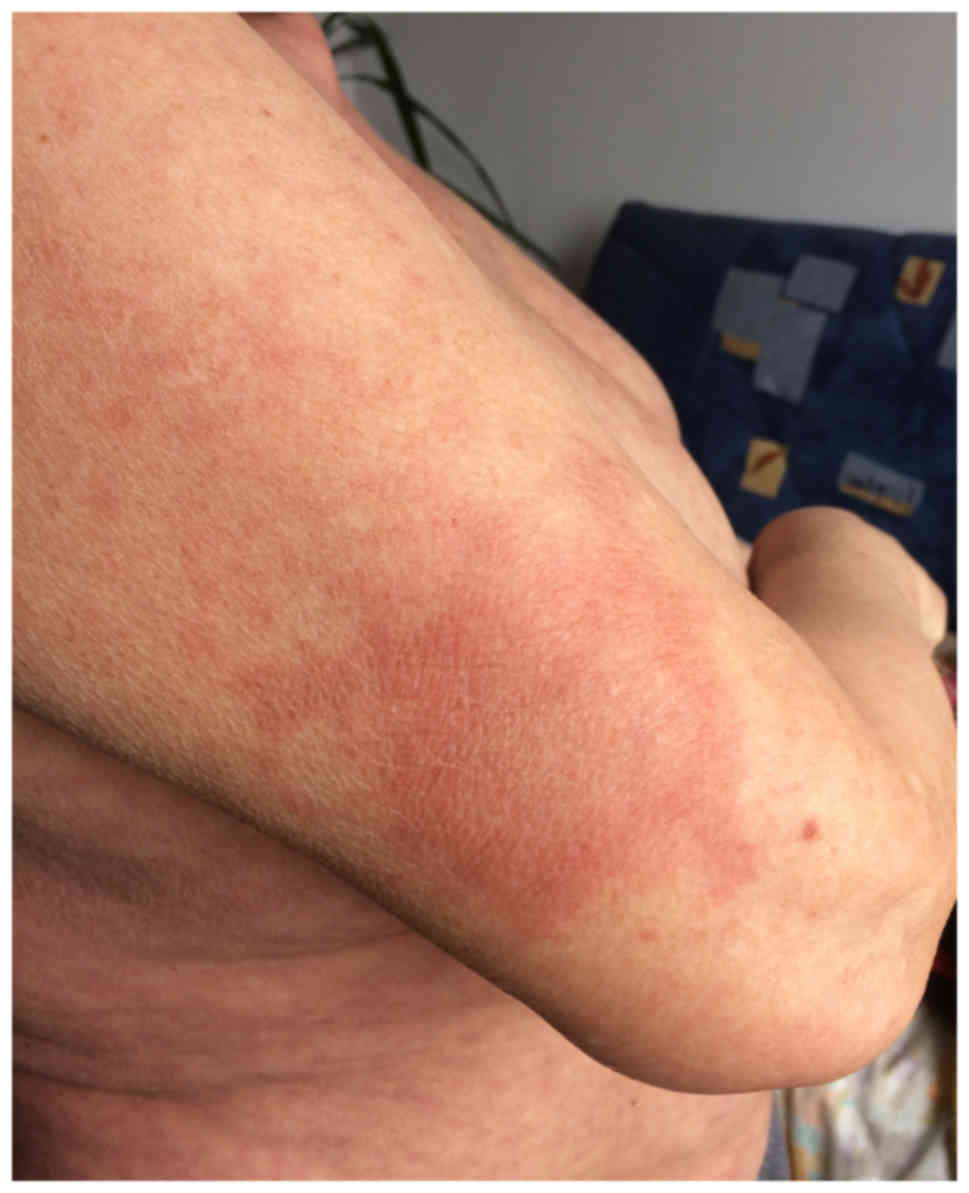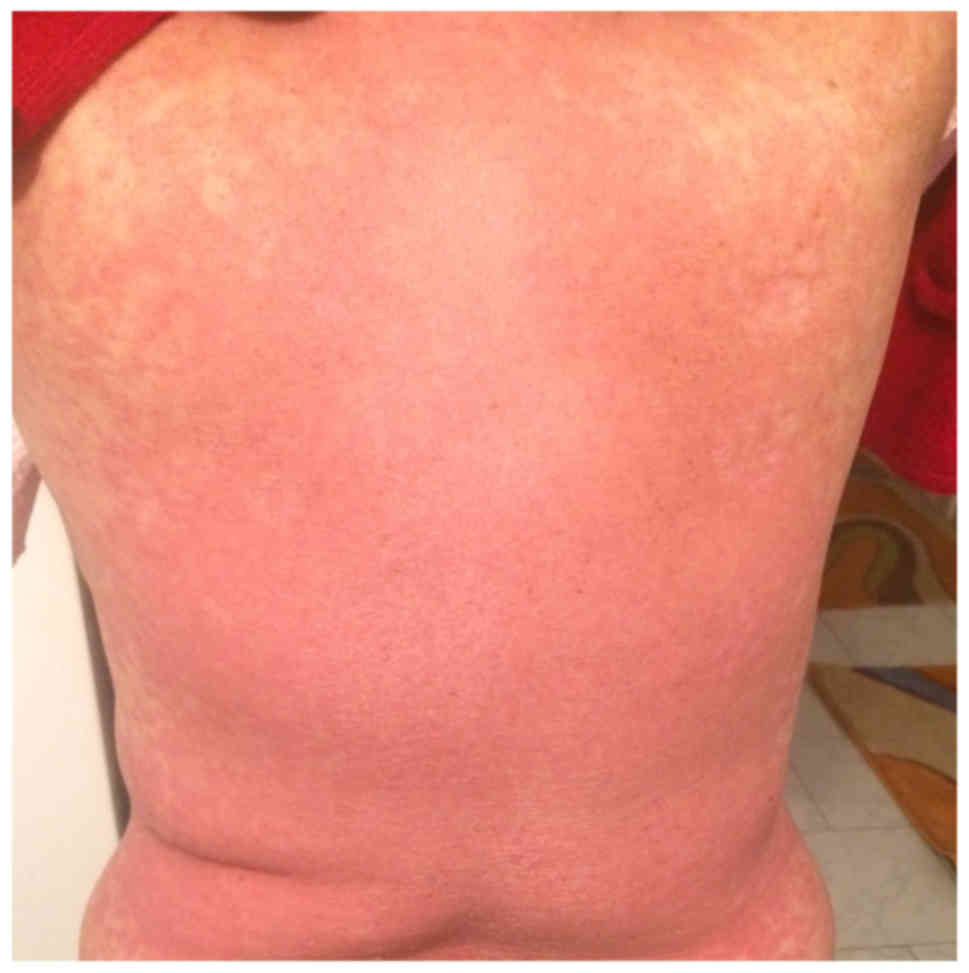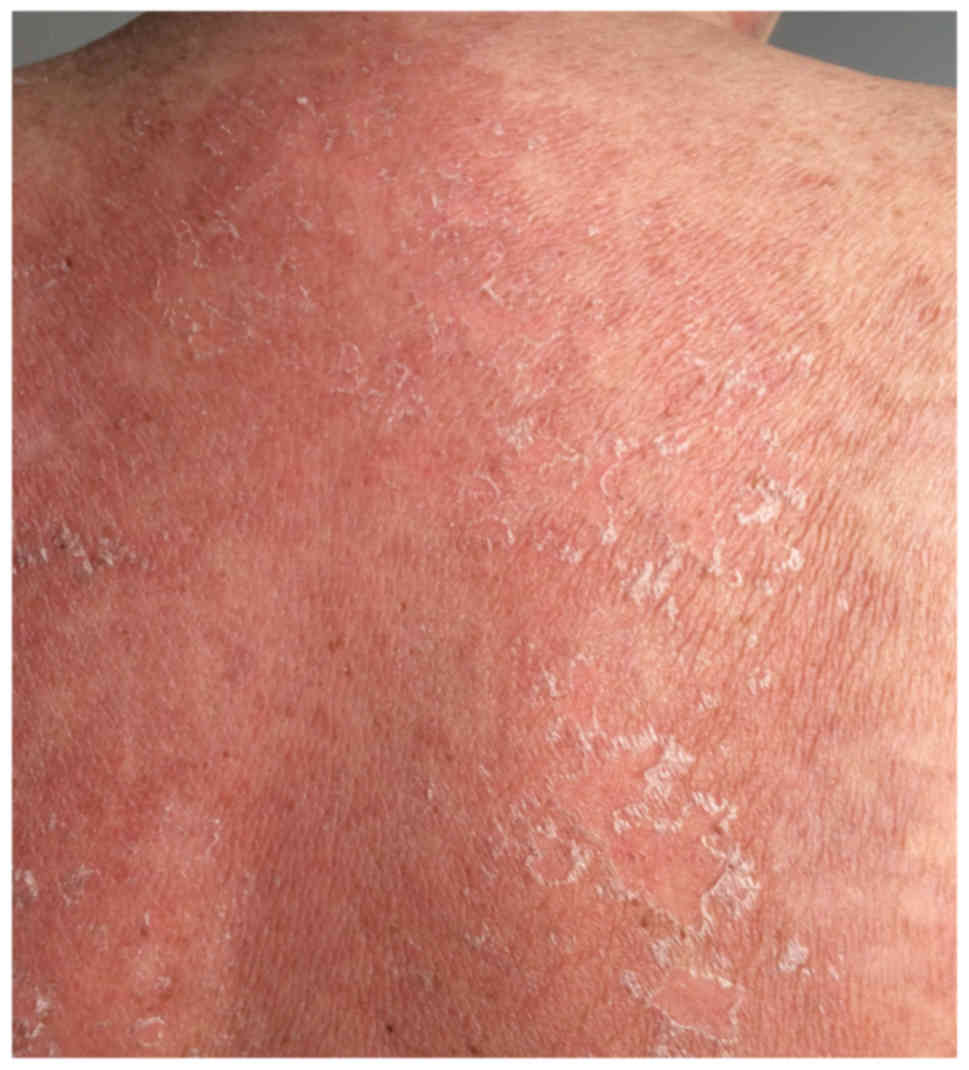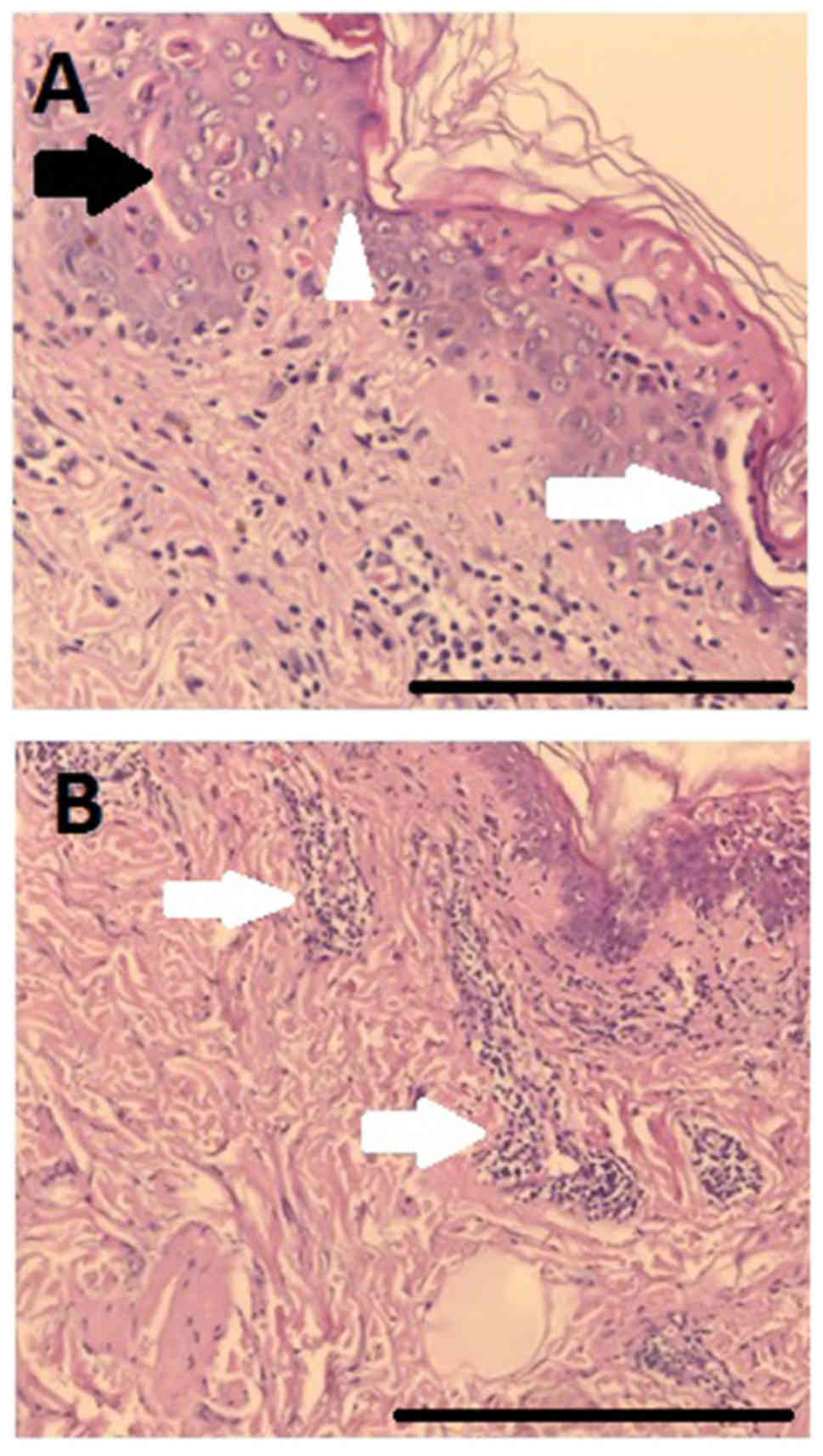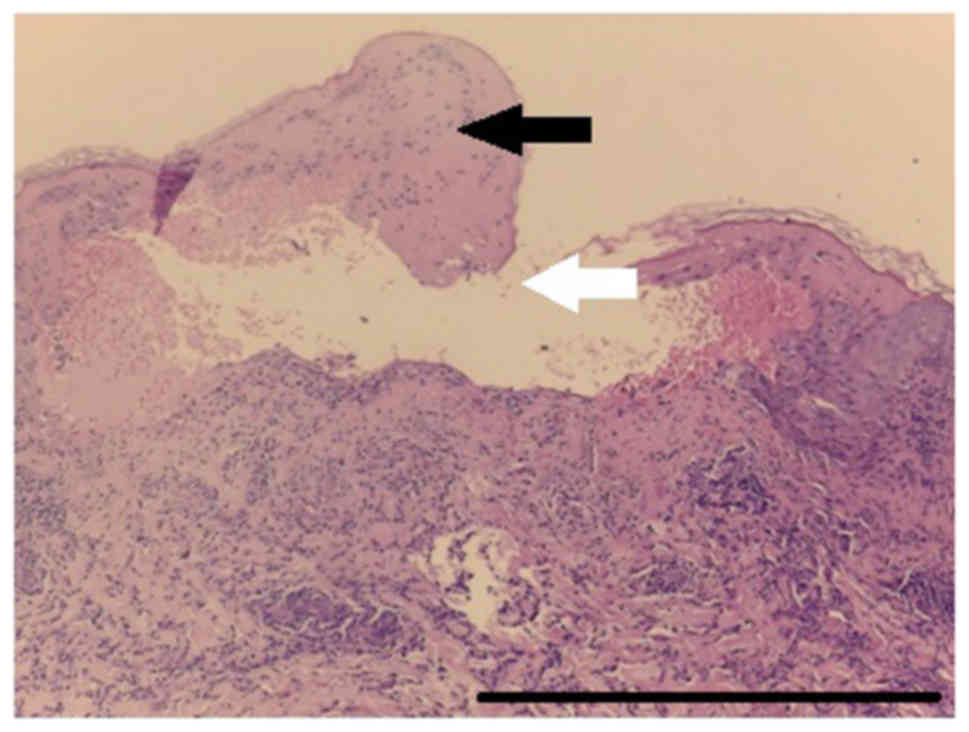Stevens‑Johnsons syndrome or drug‑induced lupus ‑ a clinical dilemma: A case report and review of the literature
- Authors:
- Published online on: May 16, 2018 https://doi.org/10.3892/br.2018.1098
- Pages: 37-41
-
Copyright: © Bojinca et al. This is an open access article distributed under the terms of Creative Commons Attribution License.
Abstract
Introduction
The widespread use of biological disease-modifying anti-rheumatic drugs (DMARDs) has improved the management of autoimmune diseases; however, these agents are also associated with a number of adverse events, some of which impact on autoimmune processes (1–3). Tumor necrosis factor (TNF) inhibitors are the first biological agents used in rheumatoid arthritis (RA) to have yielded satisfactory results, with significant decreases in the clinical activity rates (majority of patients reaching a state of clinical remission or low disease activity) and in structural damage (minimal radiographic progression) (1–3), though are also associated with a number of autoimmune systemic events (lupus, vasculitis, sarcoidosis) and localized adverse events [uveitis, psoriasis, interstitial lung disease, erythema multiforme including the major form Stevens-Johnson syndrome (SJS)] (4–8).
Drug-induced lupus (DIL) is the most frequent systemic autoimmune adverse event associated with the use of TNF inhibitors in RA, and mucocutaneous manifestations including malar rash, discoid lupus, oral ulcers, chilblain lupus and other lesions are frequently associated with general manifestations and articular symptoms (4–8). Severe manifestations of lupus (nephritis, central nervous system involvement) are rare (4–8). It is important to acknowledge that many patients with RA exhibit positivity for antinuclear antibody prior to starting anti-TNF treatment and between 15 and 80% (according to different reports) develop positivity for antinuclear antibody during therapy, some of which develop clinical manifestations, though only a minority fulfill lupus classification criteria (less than 1%) (4–8).
Certain patients with lupus induced by TNF inhibitors may develop positivity for antihistone antibodies (as in other forms of DIL), but a particular aspect is the fact that patients with lupus induced by TNF inhibitors may also frequently develop anti-double-stranded DNA (dsDNA) antibodies (as in systemic lupus erythematosus) (4–8). Hypocomplementemia is more frequently observed in lupus induced by TNF inhibitors than in other forms of drug-induced lupus (5,6).
The mechanisms underlying lupus induced by TNF inhibitors are not fully understood. It is possible that TNF inhibition leads to upregulation of interleukin (IL)-10 and B cell hyperactivity or T helper 2 cell hyperactivity with B cell activation (5,7,8). Another mechanism proposed is the decreased apoptosis of cytotoxic T cells (6). Common infections in patients treated with TNF inhibitors may activate B cell activity (5,7,8). It has also been suggested that a possible overlap of RA and underlying lupus pathology may be propagated by therapy with TNF inhibitors into a complete form of lupus (5–7). Some of the mucocutaneous manifestations may be severe and must be differentiated from allergic reactions and erythema multiforme (4–7). Stopping the application of TNF inhibitor is usually sufficient for remission of symptoms but in certain cases, glucocorticoid and immunosuppressive therapy are required (4–7). Lupus induced by TNF inhibitors has been reported also in other immune mediated diseases including Crohn's disease (CD) and less frequently in spondyloarthritis (8–12). The current report presents the case of a patient with rheumatoid arthritis who developed severe recurrent cutaneous reactions and positive autoantibodies during TNF inhibitor treatment with difficulties in differential diagnosis and treatment. A review of the literature is also presented.
Case report
The current report presents the case of a 63-year-old female patient diagnosed with RA in the outpatient department of County Hospital Tulcea (‘Spitalul Judetean Tulcea’, Tulcea, Romania) in February 2016 (symmetrical arthritis on the hands, wrists, knees, elbows and shoulders, morning stiffness for ~60 min, rheumatoid factor +, anti-citrullinated protein antibodies +++) who was treated with methotrexate 10–15 mg weekly following response failure to other DMARDs (leflunomide, hydroxychloroquine). In December 2016 the patient began biological therapy (certolizumab pegol; two subcutaneous injections of 200 mg followed by one subcutaneous administration of 200 mg every 2 weeks) and in January 2017 was admitted to the Emergency Department of ‘Sfanta Maria’ Hospital (Bucharest, Romania), with complaints of aggravated generalized erythematous rash, intense pruritus, dysphonia and difficulty in swallowing. She reported the onset of dysphonia 2 days after the first administration of certolizumab pegol, which was deemed as not notably discomforting at that time by the patient and also following the second administration (3 weeks prior to hospital presentation), but was associated with erythematous rash (Figs. 1 and 2), located at the anterior and posterior thorax, on the arms and in the lumbar region, which then associated with epidermal detachment (Fig. 3). This situation alerted the patient who presented to the Emergency Department. The diagnosis was severe allergoderma and the patient begun administration of glucocorticoid therapy (dexamethasone 8 mg, intravenous, once/day for 5 days followed by oral prednisone 30 mg/day) and oral loratadine 10 mg/day. The progression was favorable with initial marked improvement of dysphonia and skin lesions and the patient was discharged with the recommendation of tapering prednisone at 5 mg/week. However, after 6 weeks, the patient presented again at the hospital with an aggravated general condition: Malaise, an extended rash, intense arthralgia, pruritus, dysphonia and difficulty in swallowing were evident. She was urgently hospitalized and a physical examination revealed generalized maculopapular rash, severe pruritus. The patient was hemodynamically stable (normal arterial tension of 130/80 mm Hg and a regular heart rate of 88 beats/min) at that time with no signs of laryngeal edema.
Laboratory tests identified increased values for erithrocyte sedimentation rate (ESR), 80 mm/h (normal range, 2–20 mm/h); C-reactive protein level (CRP), 101 mg/l (normal range, 0–5 mg/l); normal white blood cell (WBC) count (7,800/mmc; normal range, 3,500–10,000/mmc) without any other signs of infection (references ranges of ‘Sfanta Maria’ Hospital laboratory). An extended antinuclear antibodies immunoblot profile (qualitative serum immunoblot method; Synevo Central Labs, Belro Medical S.A., Waterloo, Belgium) revealed positivity for anti-Sjögren's-syndrome-related antigen A (SS-A) and anti-Sjögren's-syndrome-related antigen B (SS-B), and anti-histone antibodies. A dermatological assessment of skin lesions concluded a diagnosis of the major form of erythema multiforme, which further prompted a cutaneous biopsy for diagnosis of SJS and differentiation from other possible diseases including Rowel syndrome, pemphigus vulgaris and bullous pemphigoid or disseminated fixed bullous drug eruption. The result of the skin biopsy employing hematoxylin and eosin staining (Figs. 4 and 5) sustained the diagnosis of SJS following anti-TNF treatment. The severity-of-illness score for toxic epidermal necrolysis (SCORTEN) was 2.
A lymphoblastic transformation test (LTT; Synevo Central Labs, Belro Medical S.A.) to certolizumab pegol was negative. Patient management included supportive care and the dose of systemic glucocorticoid was increased to 40 mg predenisone/day with which a partial response to treatment was observed. Although there was some remission of the lesion, the subsequent recurrence required prolonged hospitalization for 4 weeks (May 11 to June 9, 2017). The patient experienced several episodes of recurrence of lesions on attempt at lowering the dose of prednisone to 10 mg/day. While this was not a life-threatening case at admission, the recurrence of the skin lesion was a notable problem.
As glucocorticoid treatment was unable to attain remission of the lesions at daily doses under 15 mg prednisone, a second skin biopsy was performed that raised the suspicion of lupus erythematosus.
Based on this biopsy, a further dermatological evaluation raised the suspicion of lupus induced by TNF inhibitor therapy (DIL).
Reintroducing methotrexate (stopped during the most acute phase of skin lesions) had positive effect and the progression of the patient was favorable with the disappearance of cutaneous lesions, allowing a decrease of prednisone dose to 5 mg daily. If the activity of RA increases, it should be proposed that the patient undergoes rituximab treatment (anti lymphocyte B).
Discussion
Lupus induced by TNF inhibitors is among the most frequent autoimmune adverse events of anti-TNF therapy (4–9). Patients with RA and CD appear to be more affected than patients with spondyloarthritis by this form of DIL (4–12). Mucocutaneous manifestations, articular symptoms and general manifestations are the most common manifestations, and patients may develop positivity for antinuclear, antihistone and anti-dsDNA antibodies (4–9). The emergence of anti-dsDNA antibodies is more frequent in lupus induced by TNF inhibitors than in other forms of DIL (4–7). Usually the major manifestations of systemic lupus (nephritis, central nervous system involvement) are rare, but certain patients may develop severe forms of mucocutaneous manifestations (as in the presented patient) mimicking severe allergic reactions or erythema multiforme (4–7).
Expert opinion and the conclusions of the skin biopsies may be misleading. Laboratory tests demonstrating the occurrence of antinuclear, anti-histone and, most importantly, anti-dsDNA antibodies may orientate the diagnosis to lupus induced by TNF inhibitors. Discontinuation of the TNF inhibitor treatment is key and in some cases sufficient to stop the symptoms (4–8). However, in certain cases systemic glucocorticoid therapy and immunosuppressive treatment are required as was the situation for the presented patient.
In patients with RA who develop lupus induced by TNF inhibitors, following termination of the treatment and management of the lupus symptoms, in certain cases biological treatment is required for the reactivation of RA, and the use of a different class of biological treatment is a common decision (4,5).
The alternative diagnosis that was discussed for the present patient was a form of SJS. SJS is a rare but severe cutaneous adverse reaction related to a variety of medications (sulfonamides, NSAIDs, antimalarials, anticonvulsants, allopurinol) that predominantly involves the skin and mucous membranes (13–15). SJS may be fatal and is considered a medical emergency associated with significant morbidity and mortality (13). The extent of skin involvement is a major prognostic factor (14). The damage to the skin is considered to be mediated by cytotoxic T lymphocytes and mononuclear cells that induce apoptosis in keratinocytes expressing drug-derived antigens at their surface (15).
Initial symptoms may be unspecific (fever, stinging eyes and discomfort upon swallowing) and precede cutaneous manifestations by a few days. The early skin lesions include erythematous and livid macules, which may or may not be slightly infiltrated, and have a tendency to rapidly coalescence. In the second phase, hemorrhagic erosions and erythema typically develop, followed by varying levels of epidermal detachment, which present as blisters and areas of denuded skin. The diagnosis relies on clinical symptoms and on histological examination revealing widespread epidermal necrosis involving all layers (13–15).
Reports of SJS in patients treated with certolizumab pegol, a recombinant Fab antibody fragment against TNF-α conjugated to an ~40-kDa polyethylene glycol, are rare, but it seems to particularly affect female patients with RA of ≥60 years of age who have been taking the drug for <1 month (16).
If the SJS physiopathology remains unclear, a specific immune response to one or more drugs is typically involved, constituting a form of delayed-type hypersensitivity (15). The LTT, which measures the proliferation of T cells in response to a drug in vitro, has indicated a sensitivity of 60–70% for patients allergic to β-lactam antibiotics (17).
The earlier the causative drug is withdrawn, the better the prognosis; while patients exposed to causative drugs with long half-lives have an increased risk of mortality (18).
To standardize the evaluation of risk and prognosis, the severity-of-illness score for toxic epidermal necrolysis (SCORTEN) scale is now a widely used scoring system that evaluates the following parameters: Age, malignancy, tachycardia, initial body surface area of epidermal detachment, serum urea, glucose and bicarbonate (19,20). In the case presented the SCORTEN was 2, associated with 12.1% mortality rate.
SJS related to administration of certolizumab pegol is rare, and conversely, there are certain case reports that have identified sustained efficacy of other anti-TNF therapy (infliximab and etanercept) in the treatment of patients with severe epidermal necrolysis (21,22), though there is a lack of data for certolizumab.
It may be speculated that in the case presented, the patient developed various autoantibodies (antinuclear, antihistone and anti-dsDNA) under TNF-inhibitor treatment, but only following SJS development (potentially also induced by TNF inhibitor), the release of marked quantities of antigens from the mucocutaneous lesions may have converted the subclinical form into a clinical form of DIL.
At present, no treatment modality has been established as a standard for these patients with DIL induced by anti-TNF therapies; therefore, after stopping application of the causative drug, therapy is primarily supportive and anti-symptomatic for mild forms, while in moderate to severe forms, systemic glucocorticoids and sometimes immunosuppressive drugs and a multidisciplinary approach are required.
Acknowledgements
The authors are thankful to Professor Calin Giurcaneanu and Associate Professor Roxana Bumbacea at the Dermatology and Allergology Department of ‘Elias’ Hospital (Bucharest, Romania) and to Professor Olga Simionescu at the Dermatology Department of Colentina Hospital (Bucharest, Romania) for their dermatologic and allergologic evaluations of the patient and skin biopsies.
Funding
No funding was received.
Availability of data and materials
All data described in the current report are available from the corresponding author on reasonable request.
Authors' contributions
VCB, MG and ARB were responsible for clinical evaluation and therapeutic management of the patient, and aided the literature search. AB and CII were responsible for the processing and histological assessment of skin biopsies. SMB performed cardiological evaluation and aided the literature search. MB provided a secondary clinical opinion, oversaw manuscript writing and provided corrections to the manuscript and figures, and aided the literature search.
Ethics approval and consent to participate
The report was approved by the Ethics Committee of ‘Sfanta Maria’ Hospital, Bucharest, Romania (approval no. 5084/12; March 2018).
Consent for publication
The patient provided written consent for case publication.
Competing interests
The authors declare that they have no competing interests.
References
|
Simsek I: TNF inhibitors for rheumatoid arthritis - a year in review. Bull NYU Hosp Jt Dis. 69:220–224. 2011.PubMed/NCBI | |
|
Ma X and Xu S: TNF inhibitor therapy for rheumatoid arthritis. Biomed Rep. 1:177–184. 2013. View Article : Google Scholar : PubMed/NCBI | |
|
Smolen JS, Landewé R, Breedveld FC, Buch M, Burmester G, Dougados M, Emery P, Gaujoux-Viala C, Gossec L, Nam J, et al: EULAR recommendations for the management of rheumatoid arthritis with synthetic and biological disease-modifying antirheumatic drugs: 2013 update. Ann Rheum Dis. 73:492–509. 2014. View Article : Google Scholar : PubMed/NCBI | |
|
Perez-Alvarez R, Pérez-de-Lis M and Ramos-Casals M; BIOGEAS study group: Biologics-induced autoimmune diseases. Curr Opin Rheumatol. 25:56–64. 2013. View Article : Google Scholar : PubMed/NCBI | |
|
Vaz JL, Andrade CA, Pereira AC, Martins Mde F and Levy RA: Systematic review of infliximab-induced autoantibodies and systemic lupus erythematosus. Rev Bras Rheumatol. 53:358–364. 2013.(In English, Portuguese). | |
|
Katz U and Zandman-Goddard G: Drug-induced lupus: An update. Autoimmun Rev. 10:46–50. 2010. View Article : Google Scholar : PubMed/NCBI | |
|
Ramos-Casals M, Brito-Zerón P, Muñoz S, Soria N, Galiana D, Bertolaccini L, Cuadrado MJ and Khamashta MA: Autoimmune diseases induced by TNF-targeted therapies: Analysis of 233 cases. Medicine (Baltimore). 86:242–251. 2007. View Article : Google Scholar : PubMed/NCBI | |
|
Atzeni F, Talotta R, Salaffi F, Cassinotti A, Varisco V, Battellino M, Ardizzone S, Pace F and Sarzi-Puttini P: Immunogenicity and autoimmunity during anti-TNF therapy. Autoimmun Rev. 12:703–708. 2013. View Article : Google Scholar : PubMed/NCBI | |
|
Wetter DA and Davis MDP: Lupus-like syndrome attributable to anti-tumor necrosis factor α therapy in 14 patients during an 8-year period at Mayo Clinic. Mayo Clin Proc. 84:979–984. 2009. View Article : Google Scholar : PubMed/NCBI | |
|
Sampaio-Barros PD and van der Horst-Bruinsma IE: Adverse effects of TNF inhibitors in SpA: Are they different from RA? Best Pract Res Clin Rheumatol. 28:747–763. 2014. View Article : Google Scholar : PubMed/NCBI | |
|
Mocci G, Marzo M, Papa A, Armuzzi A and Guidi L: Dermatological adverse reactions during anti-TNF treatments: Focus on inflammatory bowel disease. J Crohn's Colitis. 7:769–779. 2013. View Article : Google Scholar | |
|
Oter-López B, Llamas-Velasco M, Sánchez-Pérez J and Dauden E: Induction of autoantibodies and autoimmune diseases in patients with psoriasis receiving tumor necrosis factor inhibitors. Actas Dermosifiliogr. 108:445–456. 2017.(In English, Spanish). View Article : Google Scholar : PubMed/NCBI | |
|
Mockenhaupt M: Stevens-Johnson syndrome and toxic epidermal necrolysis: Clinical patterns, diagnostic considerations, etiology, and therapeutic management. Semin Cutan Med Surg. 33:10–16. 2014. View Article : Google Scholar : PubMed/NCBI | |
|
Palmieri TL, Greenhalgh DG, Saffle JR, Spence RJ, Peck MD, Jeng JC, Mozingo DW, Yowler CJ, Sheridan RL, Ahrenholz DH, et al: A multicenter review of toxic epidermal necrolysis treated in U.S. burn centers at the end of the twentieth century. J Burn Care Rehabil. 23:87–96. 2002. View Article : Google Scholar : PubMed/NCBI | |
|
Fritsch PO and Sidoroff A: Drug-induced Stevens-Johnson syndrome/toxic epidermal necrolysis. Am J Clin Dermatol. 1:349–360. 2000. View Article : Google Scholar : PubMed/NCBI | |
|
Flendrie M, Vissers WH, Creemers MC, de Jong EM, van de Kerkhof PC and van Riel PL: Dermatological conditions during TNF-alpha-blocking therapy in patients with rheumatoid arthritis: A prospective study. Arthritis Res Ther. 7:R666–R676. 2005. View Article : Google Scholar : PubMed/NCBI | |
|
Pichler WJ and Tilch J: The lymphocyte transformation test in the diagnosis of drug hypersensitivity. Allergy. 59:809–820. 2004. View Article : Google Scholar : PubMed/NCBI | |
|
Garcia-Doval I, LeCleach L, Bocquet H, Otero XL and Roujeau JC: Toxic epidermal necrolysis and Stevens-Johnson syndrome: Does early withdrawal of causative drugs decrease the risk of death? Arch Dermatol. 136:323–327. 2000. View Article : Google Scholar : PubMed/NCBI | |
|
Bastuji-Garin S, Fouchard N, Bertocchi M, Roujeau JC, Revuz J and Wolkenstein P: SCORTEN: A severity-of-illness score for toxic epidermal necrolysis. J Invest Dermatol. 115:149–153. 2000. View Article : Google Scholar : PubMed/NCBI | |
|
Schneider JA and Cohen PR: Stevens-Johnson syndrome and toxic epidermal necrolysis: A concise review with a comprehensive summary of therapeutic interventions emphasizing supportive measures. Adv Ther. 34:1235–1244. 2017. View Article : Google Scholar : PubMed/NCBI | |
|
Hunger RE, Hunziker T, Buettiker U, Braathen LR and Yawalkar N: Rapid resolution of toxic epidermal necrolysis with anti-TNF-alpha treatment. J Allergy Clin Immunol. 116:923–924. 2005. View Article : Google Scholar : PubMed/NCBI | |
|
Meiss F, Helmbold P, Meykadeh N, Gaber G, Marsch WCh and Fischer M: Overlap of acute generalized exanthematous pustulosis and toxic epidermal necrolysis: response to antitumour necrosis factor-alpha antibody infliximab: report of three cases. J Eur Acad Dermatol Venereol. 21:717–719. 2007.PubMed/NCBI |



